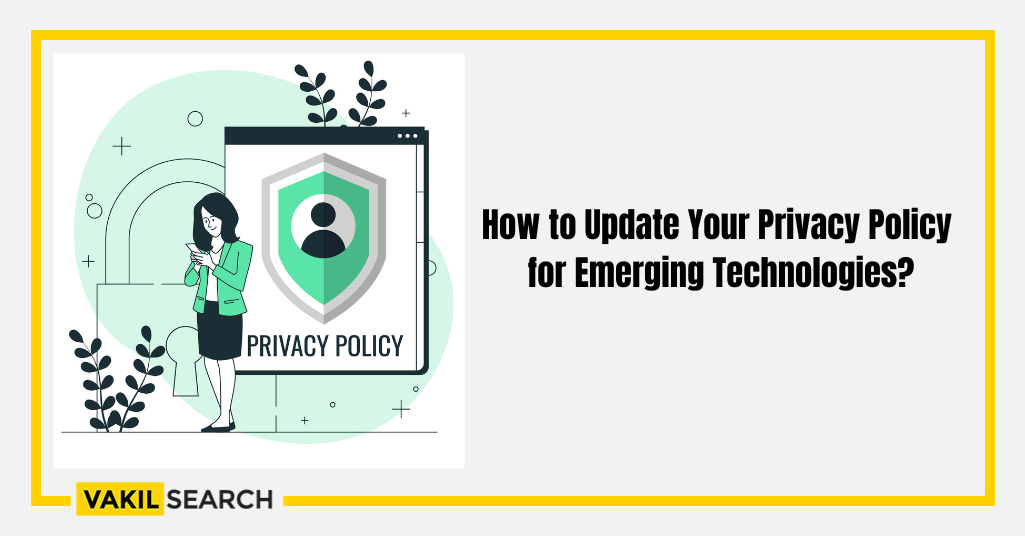Emerging technologies like artificial intelligence, machine learning, and the Internet of Things have become integral to our lives. However, they raise privacy concerns. Discover how to adapt your privacy policy to modern technologies. Learn about data collection, consent, security, and legal compliance.
Privacy Policy for Emerging Technologies
Emerging technologies such as artificial intelligence, machine learning, and the internet of things have become integral to our daily lives. However, these technologies also bring with them privacy concerns, which is why it’s essential to update your privacy policy to reflect the use of these new technologies. This article will discuss how to update your privacy policy for emerging technologies.
How to Update Your Privacy Policy for Emerging Technologies?
Identify the Data You Collect and Process
The first step in updating your privacy policy is identifying the data you collect and process. This includes both personal and non-personal data. Personal data is any information that can be used to identify an individual, such as their name, address, or email address. Non-personal data includes information that does not identify an individual, such as their browsing history or device information.
Determine How You Use the Data Privacy Policy for Emerging Technologies
Once you’ve identified the data you collect and process, the next step is to determine how you use the data. This includes the purpose for which you collect the data, how long you retain the data, and who you share the data with.
For example, if you use artificial intelligence to analyze user data, you need to specify how you use the data and what insights you gain from it. You also need to specify who you share the data with, such as third-party vendors or advertisers.
Update Your Privacy Policy
Now that you’ve identified the data you collect and how you use it, it’s time to update your privacy policy. Your privacy policy should be clear, concise, and easy to understand. It should also be written in a language that is accessible to the general public.
Your privacy policy should also include the following:
- The types of data you collect and process
- The purpose for which you collect the data
- The legal basis for collecting and processing the data
- How long you retain the data
- Who you share the data with
- How you protect the data
- Your users’ rights about their data
Privacy Policy for Emerging Technologies- Obtain Consent
Consent is critical to updating your privacy policy for emerging technologies. You must obtain consent from your users before collecting and processing their data. This includes both personal and non-personal data.
Obtaining consent means that your users understand and agree to your privacy policy. It also means they understand how you use their data and who you share it with. You can obtain consent through a consent form or by including a checkbox on your website.
Train Your Employees
More than updating your privacy policy is required; you must also train your employees. Your employees must understand the privacy policy and how it relates to their job duties. They must also understand the importance of protecting user data.
Training employees on privacy policies and emerging technologies can prevent data breaches and other issues. This training can be done through online courses, workshops, or in-person sessions.
Conduct Regular Audits
Finally, conducting regular audits of your privacy policy is essential. Your privacy policy should be reviewed and updated regularly to reflect changes in emerging technologies, legal requirements, and business practices.
Regular audits can help you identify gaps in your privacy policy and take corrective action. It can also help you avoid emerging privacy concerns and protect your users’ data.
Address Data Security and Data Breaches
With emerging technologies come new risks and security concerns. It’s important to address these concerns in your privacy policy and inform users of your measures to protect their data. This may include encryption, firewalls, access controls, and other security measures.
You should also include a section in your privacy policy that addresses data breaches. This section should explain what constitutes a data breach, how you detect and respond to data breaches and the steps you take to mitigate any harm caused.
Provide Transparency and Control
Users want transparency and control over their data. Your privacy policy should reflect this by explaining how users can access, update, or delete their data. This includes allowing users to opt-out of data collection or processing for certain purposes.
You can also give users control over the types of notifications they receive from your website or app. For example, give them the option to opt out of promotional emails or push notifications.
Consider Local and International Privacy Laws
Different countries and regions have different privacy laws that you must comply with. It’s important to understand these laws and update your privacy policy accordingly. This includes GDPR, CCPA, and other privacy regulations.
If you operate in multiple countries or regions, you may need to create different versions of your privacy policy that comply with local laws. For example, you may need a separate privacy policy for users in the European Union and another one for users in the United States.
Be Transparent About Third-Party Services
Many websites and apps use third-party services to improve their functionality or provide additional features. If you use third-party services, it’s important to be transparent about these services in your privacy policy.
You should explain what data is shared with third-party services and how these services use the data. You should also provide links to the privacy policies of these services so that users can review them.
Challenges and Limitations:
When updating your privacy policy for emerging technologies, several challenges and limitations come into play:
Complexity of Emerging Technologies:
Integrating privacy measures for emerging technologies like AI, machine learning, and IoT can be intricate due to their evolving nature. These technologies often process vast amounts of data, making it challenging to clearly define how data is used and protected.
Changing Regulatory Landscape:
As technology advances, the regulatory environment evolves as well. Adapting your privacy policy to comply with new and changing laws can be demanding, especially if you operate in multiple regions with different regulations.
Balancing Transparency and Complexity:
While transparency is essential, explaining the intricacies of data processing in emerging technologies to users who might not be tech-savvy can be complex. Striking a balance between transparency and user-friendliness is a challenge.
Obtaining Informed Consent:
Acquiring informed consent is crucial, but it’s challenging to ensure users fully comprehend the implications of data processing in complex technologies. Users might consent without fully understanding the extent of data usage.
Data Security:
As emerging technologies gather and process large volumes of data, ensuring robust data security becomes paramount. The challenge lies in safeguarding data against breaches, cyberattacks, and unauthorised access.
User Control and Choice:
Providing users with control over their data while accommodating the dynamic features of emerging technologies can be limiting. Offering meaningful choices without compromising the technology’s functionality requires careful consideration.
Scope of Data Collection:
Determining the scope of data collection becomes intricate in technologies like AI that gather data from various sources. It’s challenging to define what constitutes personal data in complex data ecosystems.
Third-Party Involvement:
Emerging technologies often involve third-party tools and services. Clearly articulating how these third parties handle user data can be challenging, especially when these services have their own privacy policies.
Educating Employees:
Ensuring that employees understand the intricacies of privacy policy updates related to emerging technologies requires training and continuous education. Misunderstandings could lead to errors in implementation.
Encrypted Data Processing Tools and Their Uses:
In the realm of emerging technologies, safeguarding user data is paramount. Encrypted data processing tools offer a robust solution to address privacy concerns. Here are some tools commonly used in India, along with their key uses:
Encrypted Data Processing Tools
-
Microsoft Azure Confidential Computing:
Uses: Ensuring data confidentiality during processing.
How: Utilises secure enclaves to keep data encrypted while being processed, maintaining privacy.
-
IBM Homomorphic Encryption Toolkit:
Uses: Enabling computations on encrypted data.
How: Allows advanced analytics without decrypting data, preserving its privacy.
-
SecureLayer Data Masking:
Uses: Safeguarding sensitive data during testing and analytics.
How: Replaces sensitive data with fictitious information, ensuring secure analysis without exposure.
-
Tata Communications Secure Connected Digital Experience:
Uses: Secure data processing and compliance.
How: Offers encrypted solutions to ensure data privacy and meet regulatory requirements.
-
Lucipher (Open-source Cryptographic Library):
Uses: Comprehensive encryption options for data security.
How: Provides various encryption algorithms for secure data storage and processing.
-
Netskope Security Cloud:
Uses: Ensuring data protection in cloud and web environments.
How: Provides encryption and security services to secure data during processing and transit.
-
Crypteron Data Security Platform:
Uses: Holistic data protection at various stages.
How: Encrypts data at rest, during transit, and during processing for comprehensive security.
Using and understanding these tools, businesses can enhance their data security measures while benefiting from emerging technologies. These solutions enable secure data processing, analytics, and compliance, fostering trust among users and ensuring privacy in the digital age.
Conclusion
Updating your privacy policy for emerging technologies is essential for protecting your users’ data and staying compliant with legal requirements. It’s essential to identify the data you collect and process, determine how you use the data, update your privacy policy, obtain consent, train your employees, and conduct regular audits.
By following these steps, you can stay ahead of emerging privacy concerns and protect your users’ data. Remember that privacy policies should be written in a language that is accessible to the general public, and obtaining consent is critical.
Vakilsearch is an online legal services provider that can help you update your privacy policy for emerging technologies. Our team of experienced lawyers can review your current privacy policy, identify areas of improvement, and draft a new policy that complies with local and international privacy laws. We can also provide guidance on employee training, regular audits, and data security measures. With Vakilsearch, you can ensure that your privacy policy is clear, and transparent, and protects your users’ data.










